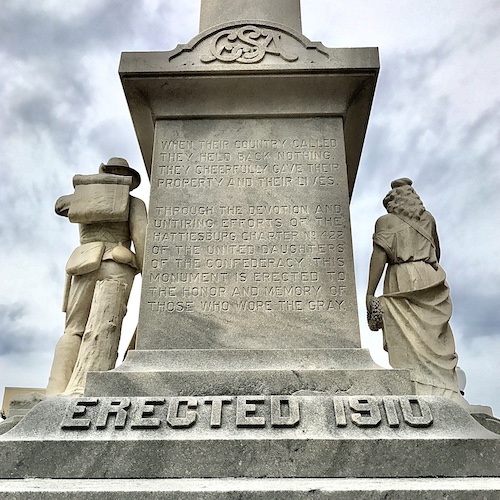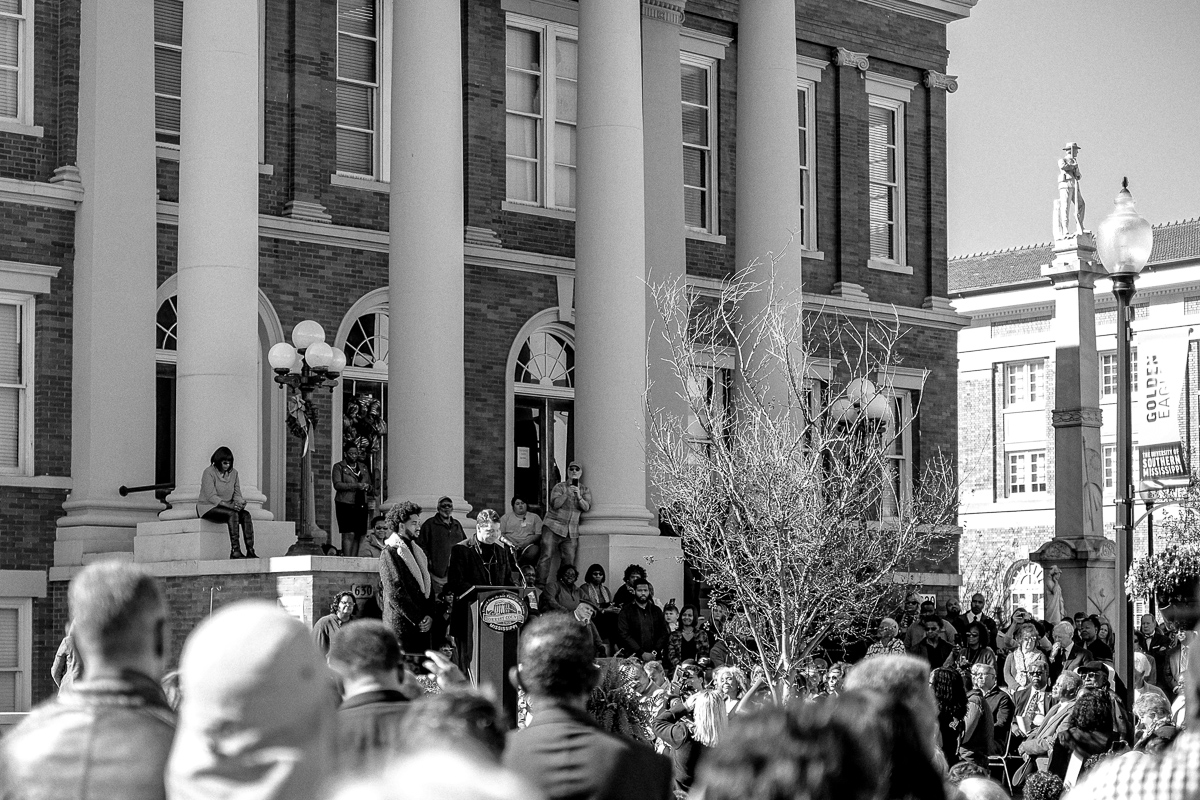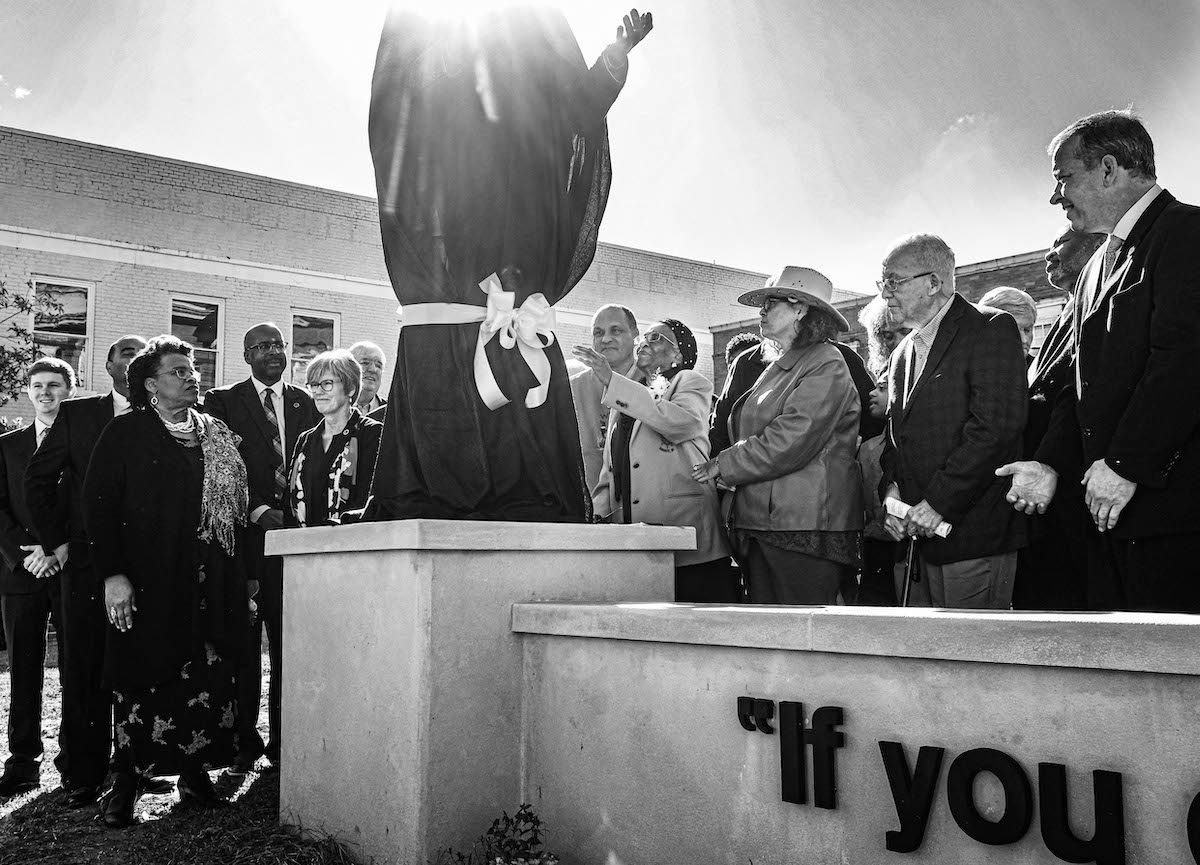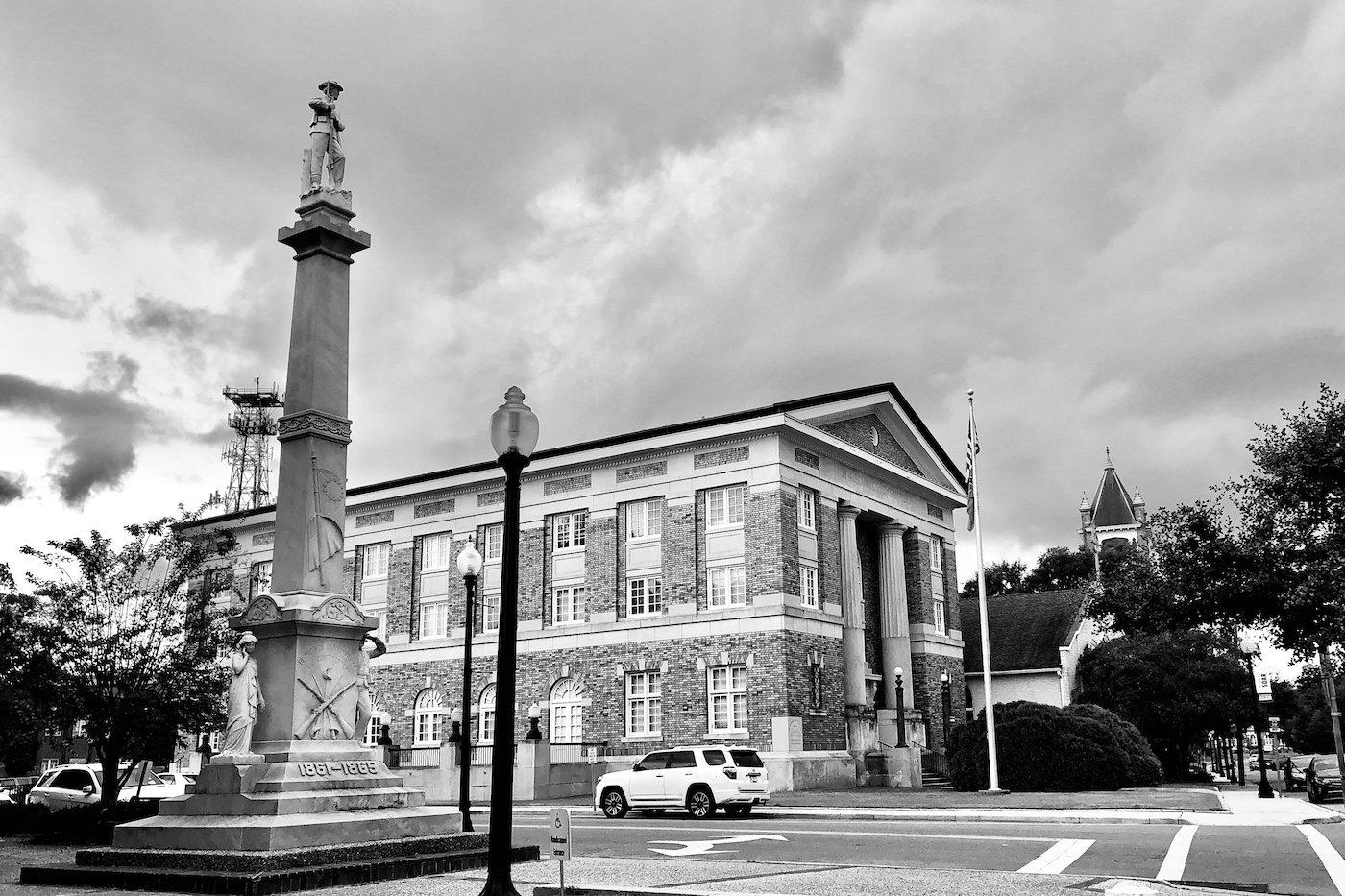HATTIESBURG—A towering Confederate monument will likely continue to stand next to the Forrest County Courthouse in majority-Black Hattiesburg, Miss., after a county-wide referendum to remove it narrowly failed in a 51% to 49% vote.
The United Daughters of the Confederacy gifted the monument to the city in 1910 as part of an effort to recast the pro-slavery Confederates states’ cause as noble.
In early January, Hattiesburg Councilwoman Deborah Delgado, who is Black, took part in the unveiling of a new monument to slain African American voting-rights activist Vernon Dahmer. That monument now sits on the left lawn of the Forrest County Courthouse—opposite the looming Confederate monument on the building’s right side.
Visitors to the city are “probably a little confused” at the stark difference between the two monuments, Delgado told the Mississippi Free Press earlier this year.
“The tallest one is the one that was put there following the Civil War,” she said. “That just cause resulted in the murder of this man who was pursuing civil rights. And then we let this thing that caused his murder continue to stand. It’s amazing.”
Dahmer, who fought for the right of Forrest County’s Black residents to vote, died in 1966 after fighting off the Ku Klux Klan, who had firebombed his home, while his wife and children escaped. His wife, Ellie Dahmer, later ran and won election as a Forrest County election commissioner.
Majority-White Towns Overruled City’s Support for Removal
Most Hattiesburg residents voted for the Confederate monument’s removal on Nov. 3, with up to 85% of the college town’s residents voting to get rid of it.
But residents in other, whiter towns and communities in the county voted for the monument to continue standing on Main Street in downtown Hattiesburg. That includes majority-white Dixie, located about 10 miles south of Hattiesburg, where almost 80% voted against removal.
The monument is on Forrest County property, and only the county can remove it. Countywide, 14,908 people voted to remove the monument and 15,706 voted to keep it. Residents in west Hattiesburg, which is located in Lamar County and grew out of white flight after public school desegregation, did not vote on the monument because they are not located in Forrest County.
Majorities of voters in Petal, located across the Leaf River from downtown Hattiesburg, also voted to keep the monument up in Hattiesburg.
Petal, which became a white-flight destination for white families fleeing Hattiesburg after public-school desegregation, was the home of the late Mordaunt W. Hamilton Sr. He owned the Hattiesburg hardware store where Samuel Bowers and other members of the White Knights of the Ku Klux Klan met to plot Dahmer’s murder in 1966. Hamilton helped set up segregation academies in Hattiesburg and Petal.
In May, Petal made national headlines when its conservative mayor, Hal Marx, made incendiary remarks about the police killing of George Floyd in Minneapolis. Hundreds of activists and embarrassed residents accused him of a history of “racist” remarks and actions and urged him to resign. The mayor refused to step down.
‘Symbols Matter’
Early this year, before the deaths of Floyd and other African Americans like Breonna Taylor sparked a nationwide reckoning on race, Councilwoman Delgado said she was “hopeful” that the county would remove the monument “someday.”
She also said she hopes the county will someday change its name, which honors Confederate general and original Ku Klux Klan grand wizard Nathan Bedford Forrest.
“Mississippi already has a lot to account for when we go before the Lord, but I do think that one of the things we can do in Forrest County is to change that name or just use the name of a forest—remove an ‘r.’ But we can also remove that Confederate statue, because that is not an indication of anything that was great about our area,” the councilwoman said.
Local activists and leaders began pushing for the monument’s removal in earnest over the summer, as a wave of anti-racist activism swept across America—including in Forrest County.

“Symbols matter. They reflect the values and character of a community. A symbol shines light on what is seemingly important for the people it represents,” Hattiesburg Mayor Toby Barker said during a speech on the issue in early June.
“History cannot be replaced. However, there comes a time when some symbols, whether a state flag or a monument, do not need to be front and center. Stories can be told, lessons can be taught and people can be remembered without magnifying those symbols that many rightfully deem offensive.”
Fewer than two weeks before the Mississippi Legislature voted to retire the Confederate-themed 1894 state flag, the Forrest County Board of Supervisors voted 3-2 to put the issue on the Nov. 3 ballot via a non-binding resolution that would allow the supervisors an opportunity to gauge where constituents stood on the issue before making a decision.
Supervisors Sharon Thompson, Roderick Woullard and David Hogan, the board president, voted for the referendum. The two supervisors who voted against the measure were supervisors Burkett Ross and Chris Bowen, who said the referendum should include both monuments, meaning that if voters wanted to remove the Confederate monument, they would have to vote to remove the new Dahmer monument, too.
Forrest County Board of Supervisors President David Hogan, who helped prosecute Sam Bowers, the man who murdered Dahmer, disagreed with two other members of the board who thought the supervisors themselves should vote to remove the monument without asking voters. Hogan, The Hattiesburg American reported in June, “said he (had) faith county voters (would) do the right thing and vote the statue out.”
In June, the Forrest County Board of Supervisors suggested that, if voters approved moving the monument, the city could split the cost of relocating the Confederate monument to the Oaklawn Cemetery on Hardy Street, which contains the graves of nearly 60 Confederate veterans.
Despite the narrow loss for proponents of moving the monument, the county board could still take the issue up later and decide to remove the monument if they choose despite the narrow loss, but its members have not announced plans to revisit the monument.
‘The Greatest Event in Hattiesburg’s History’
Efforts to get the monument removed are not new. During the Freedom Summer protests of 1964, local businesswoman and civil-rights activist Peggy Jean Connor and a group of fellow activists picketed for the removal of the monument outside the Forrest County Courthouse. That protest landed the activists in jail.
The United Daughters of the Confederacy inscribed on the monument that its purpose was to honor “the memory of those who wore the gray.” But neither Hattiesburg nor Forrest County existed at the time of the Civil War. William Harris Hardy, a Confederate veteran, founded the city several decades afterward.
Ida V. May, the third wife of Hattiesburg’s founder, started the Forrest County Branch of the United Daughters of the Confederacy. In the early 1900s, she worked to secure the legacy of the Confederacy in the city’s iconography, including with the courthouse monument.

When the city held the unveiling ceremony for the monument in October 1910, a Hattiesburg Daily News heralded it as “The Greatest Event in Hattiesburg’s History,” complete with a “magnificent street pageant, automobile parade, demonstration by fire department” and fireworks. Confederate veterans from across the city poured in to the city to have a reunion amidst the unveiling.
Then-Forrest County Supervisor Stokes V. Robertson gave a grand speech praising the white granite statue and the county’s namesake—Confederate General Nathan Bedford Forrest, who later helped found the Ku Klux Klan and served as its first grand wizard.
“Forrest County, a mere baby in the state’s great sisterhood of counties, has started out right,” Robertson declared. “In the outset, it was named for the South’s intrepid cavalry leader, Nathan Bedford Forrest: and today, before its third anniversary, it is entertaining a reunion of Confederate veterans of the state and is unveiling this monument, thereby becoming one of the leaders in the list of counties who are preparing properly and suitably to perpetuate the memory of the grandest army that ever fought a foe.”
‘We Shouldn’t Be Lying to Our Children’
Earlier this year, Hattiesburg Councilwoman Delgado told the Mississippi Free Press that she has decried the prominence Forrest’s legacy in the county and throughout the city since Hattiesburg first elected her to the city council 20 years ago.
“When I first got elected, his picture was hanging in City Hall. I would pass it and just say, ‘Oh my God’ and have tremors. I was already controversial and just didn’t want to have that added to my list of complaints that the community had against me,” the Black councilwoman said. “But it was a problem for me.”

One day, though, Delgado was walking down a stairway in the building when she saw an employee giving local elementary school students a tour of the City Hall.
“She was at that picture explaining to those kids who this man was. She said he was just a famous person and a person who was valuable to the history of Mississippi,” Delgado said. “And I stood there waiting for her to say he was a founder of the Ku Klux Klan and about all the murders he committed. And she didn’t say one thing.”
That incident prompted the councilwoman to tell local leaders that the portrait “needed to go.”
“We shouldn’t be lying to our children. They’ve got enough misinformation about the history of our state and our history,” Delgado told the Mississippi Free Press. “We don’t need to have that perpetuated. That was a challenge, but shortly thereafter, that picture disappeared.”
William Pittman contributed to this report with data analysis and the included infographic.
Correction: An earlier version of this story referred to Hattiesburg founder W.H. Hardy’s second wife and the city’s namesake, Hattie Lott, as the founder of the Forrest County chapter of the United Daughters of the Confederacy. Hattie Lott died before the UDC’s founding. Hardy’s third wife, Ida V. May, founded the organization. We apologize for this error. Special thanks to Benjamin Morris for pointing it out.






